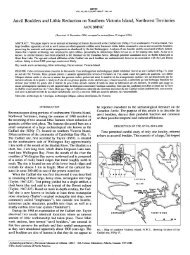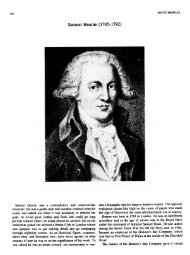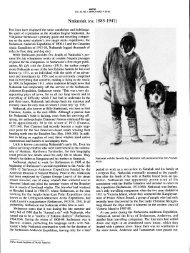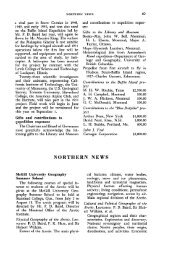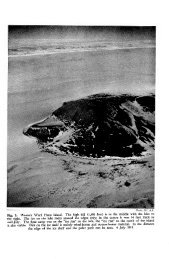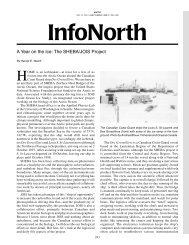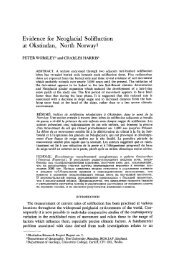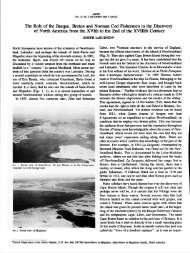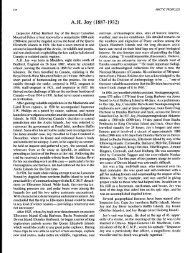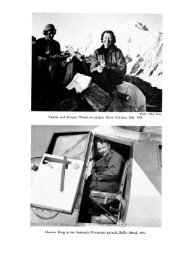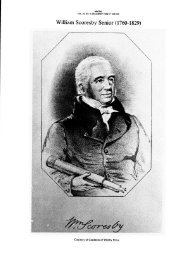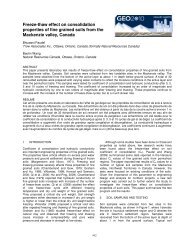Effects of Crude and Diesel Oil Spills on Plant Communities ... - arctic
Effects of Crude and Diesel Oil Spills on Plant Communities ... - arctic
Effects of Crude and Diesel Oil Spills on Plant Communities ... - arctic
Create successful ePaper yourself
Turn your PDF publications into a flip-book with our unique Google optimized e-Paper software.
ARCTIC<br />
VOL. 31, NO. 3 (SEPT. 1978), P. 242-259.<br />
<str<strong>on</strong>g>Effects</str<strong>on</strong>g> <str<strong>on</strong>g>of</str<strong>on</strong>g> <str<strong>on</strong>g>Crude</str<strong>on</strong>g> <str<strong>on</strong>g>and</str<strong>on</strong>g> <str<strong>on</strong>g>Diesel</str<strong>on</strong>g> <str<strong>on</strong>g>Oil</str<strong>on</strong>g> <str<strong>on</strong>g>Spills</str<strong>on</strong>g> <strong>on</strong> <strong>Plant</strong><br />
<strong>Communities</strong> at Prudhoe Bay, Alaska, <str<strong>on</strong>g>and</str<strong>on</strong>g> the<br />
Derivati<strong>on</strong> <str<strong>on</strong>g>of</str<strong>on</strong>g> <str<strong>on</strong>g>Oil</str<strong>on</strong>g> Spill Sensitivity Maps<br />
D. A. WALKER’, P. J. WEBBER’, K. R. EVERETT* <str<strong>on</strong>g>and</str<strong>on</strong>g> J. BROWN3<br />
ABSTRACT. <str<strong>on</strong>g>Crude</str<strong>on</strong>g> oil was spilled <strong>on</strong> six <str<strong>on</strong>g>of</str<strong>on</strong>g> the major Prudhoe Bay plant communities at<br />
an intensity <str<strong>on</strong>g>of</str<strong>on</strong>g> 12 1 m-2. The communities occurred al<strong>on</strong>g a topographic-moisture<br />
gradient. The reacti<strong>on</strong> <str<strong>on</strong>g>of</str<strong>on</strong>g> the major species <str<strong>on</strong>g>of</str<strong>on</strong>g> the various communities was recorded<br />
<strong>on</strong>e year following the spills.<br />
Sedges <str<strong>on</strong>g>and</str<strong>on</strong>g> willows showed substantial recovery from crude oil spills. Mosses,<br />
lichens, <str<strong>on</strong>g>and</str<strong>on</strong>g> most dicotyled<strong>on</strong>s showed little or no recovery. On a very wet plot with<br />
st<str<strong>on</strong>g>and</str<strong>on</strong>g>ing water, the vegetati<strong>on</strong> showed total recovery <strong>on</strong>e year following the spill. Dry<br />
plots, <strong>on</strong> the other h<str<strong>on</strong>g>and</str<strong>on</strong>g>, showed very poor recovery. Dryus integrz’joliu M. Vahl, the most<br />
important vascular species <strong>on</strong> dry sites, was killed. Identical experiments using diesel<br />
oil rather than crude oil showed all species except an aquatic moss to be killed. A<br />
sensitivity index for the communities was calculated <strong>on</strong> the basis <str<strong>on</strong>g>of</str<strong>on</strong>g> the percentage<br />
cover <str<strong>on</strong>g>of</str<strong>on</strong>g> the resistant species divided by the original total plant cover <str<strong>on</strong>g>of</str<strong>on</strong>g> the<br />
community. With this informati<strong>on</strong> an oil spill sensitivity map for an area <str<strong>on</strong>g>of</str<strong>on</strong>g> Prudhoe<br />
Bay was c<strong>on</strong>structed using a vegetati<strong>on</strong> map as a base.<br />
Using the crude oil data from Prudhoe Bay together with some from the literature, a<br />
predictive sensitivity map was also c<strong>on</strong>structed for an accidental crude oil spill at<br />
nearby Franklin Bluffs. In this example all the community types are c<strong>on</strong>sidered to have<br />
moderate to excellent recovery potential.<br />
Implicati<strong>on</strong>s <str<strong>on</strong>g>of</str<strong>on</strong>g> the experiments <str<strong>on</strong>g>and</str<strong>on</strong>g> the mapping exercises for oil spill c<strong>on</strong>tingency<br />
planning are discussed.<br />
Rl?WMfi. On a tcoule du brut au taux de 12 litres/m2 sur 6 des principales col<strong>on</strong>ies<br />
vegetales de Prudhoe Bay. Les col<strong>on</strong>ies se situaient suivant un gradient a I’humidite,<br />
liee a la topographie. Un an apres I’ecoulement, <strong>on</strong> enregistrait la reacti<strong>on</strong> des<br />
principales espkces de ces col<strong>on</strong>ies diverses.<br />
Les roseaux et saules m<strong>on</strong>traient un recouvrement substantiel provenant de<br />
I’ecoulement de petrole. Les mousses, lichens et la plupart des dicotyled<strong>on</strong>s m<strong>on</strong>traient<br />
peu ou pas de recouvrement. Sur un terrain trts humide, avec de I’eau stagnante la<br />
vegetati<strong>on</strong> m<strong>on</strong>trait un recouvrement total, un an aprks I’ecoulement. Dautre part, sur<br />
les terrains secs, <strong>on</strong> ne voyait qu’un faible recouvrement. “Dryas inrergrifo[ia,” I’espbce<br />
vasculaire la plus importante sur les sites secs, crevait. Des differences identiques, en<br />
utilisant du gazoil plut8t que du brut, m<strong>on</strong>traient que toutes les especes, sauf une<br />
mousse aquatique, crevaient. On calculait un index de sensibilite des col<strong>on</strong>ies, sur la<br />
base du pourcentage du recouvrement des especes resistantes par rapport au<br />
recouvrement total original de la col<strong>on</strong>ie vegetale. A partir de cette informati<strong>on</strong>, une<br />
carte de sensibilite a I’ecoulement du petrole, etait dessinke pour une regi<strong>on</strong> de Prudhoe<br />
Bay, en utilisant comme base une carte de vegetati<strong>on</strong>. En utilisant les d<strong>on</strong>nees de<br />
traitement du petrole venant de Prudhoe Bay avec d’autres tirees de la literature, <strong>on</strong><br />
dessinait aussi une carte de previsi<strong>on</strong> de sensibilite en cas d’un ecoulement accidentel<br />
‘Institute <str<strong>on</strong>g>of</str<strong>on</strong>g> Arctic <str<strong>on</strong>g>and</str<strong>on</strong>g> Alpine Research <str<strong>on</strong>g>and</str<strong>on</strong>g> Department <str<strong>on</strong>g>of</str<strong>on</strong>g> Envir<strong>on</strong>mental, Populati<strong>on</strong> <str<strong>on</strong>g>and</str<strong>on</strong>g><br />
Organismic Biology, University <str<strong>on</strong>g>of</str<strong>on</strong>g> Colorado, Boulder, Colorado, USA.<br />
21nstitute <str<strong>on</strong>g>of</str<strong>on</strong>g> Polar Studies <str<strong>on</strong>g>and</str<strong>on</strong>g> Department <str<strong>on</strong>g>of</str<strong>on</strong>g> Agr<strong>on</strong>omy, The Ohio State University, Columbus,<br />
Ohio, USA.<br />
’US. Army Cold Regi<strong>on</strong>s Research <str<strong>on</strong>g>and</str<strong>on</strong>g> Engineering Laboratory, Hanover, New Hampshire,<br />
USA.
EFFECTS OF CRUDE AND DIESEL OIL SPILLS 243<br />
du brut au voisinage de Franklin Bluffs. Dans cet exemple, <strong>on</strong> a c<strong>on</strong>sider6 que tous les<br />
types de col<strong>on</strong>ies avaient un potentiel de recouvrement modere A excellent.<br />
On discute des implicati<strong>on</strong>s de ces experiences et des essais de cartes en vue d’un<br />
programme Cventuel d’ecoulement de petrole.<br />
Traduit par Alain de Vendigies, Aquitaine Co. <str<strong>on</strong>g>of</str<strong>on</strong>g> Canada Ltd.<br />
INTRODUCTION<br />
Prudhoe Bay with its many oil wells <str<strong>on</strong>g>and</str<strong>on</strong>g> the web <str<strong>on</strong>g>of</str<strong>on</strong>g> flowlines, has a higher<br />
likelihood <str<strong>on</strong>g>of</str<strong>on</strong>g> major terrestrial spills than any other place in Alaska. <str<strong>on</strong>g>Oil</str<strong>on</strong>g> spill<br />
c<strong>on</strong>tingency planning is an integral part <str<strong>on</strong>g>of</str<strong>on</strong>g> Prudhoe Bay operati<strong>on</strong>s. This can<br />
be complimented by preparati<strong>on</strong> <str<strong>on</strong>g>of</str<strong>on</strong>g> maps which predict the sensitivity <str<strong>on</strong>g>of</str<strong>on</strong>g><br />
various ecosystems to oil spills. This approach can be used far locating future<br />
drill sites <str<strong>on</strong>g>and</str<strong>on</strong>g> pipelines so that sensitive areas might be avoided, <str<strong>on</strong>g>and</str<strong>on</strong>g> in the<br />
event <str<strong>on</strong>g>of</str<strong>on</strong>g> a spill, selecti<strong>on</strong> <str<strong>on</strong>g>of</str<strong>on</strong>g> clean-up techniques might be suggested. Such<br />
maps must be based <strong>on</strong> a thorough underst<str<strong>on</strong>g>and</str<strong>on</strong>g>ing <str<strong>on</strong>g>of</str<strong>on</strong>g> the ecology <str<strong>on</strong>g>of</str<strong>on</strong>g> the regi<strong>on</strong><br />
including the plant communities, l<str<strong>on</strong>g>and</str<strong>on</strong>g>forms, soils <str<strong>on</strong>g>and</str<strong>on</strong>g> animal populati<strong>on</strong>s.<br />
METHODS<br />
A vegetati<strong>on</strong> map was c<strong>on</strong>structed at a scale <str<strong>on</strong>g>of</str<strong>on</strong>g> 1:6,000 for a small area near<br />
the Putuligayuk River (70” 16’ 30” N. 148” 32’ W) at Prudhoe Bay. The<br />
vegetati<strong>on</strong> map was c<strong>on</strong>structed using the master map method (Everett et al.,<br />
1978). A master map is <strong>on</strong>e which has vegetati<strong>on</strong>, soil, l<str<strong>on</strong>g>and</str<strong>on</strong>g>form <str<strong>on</strong>g>and</str<strong>on</strong>g> slope<br />
informati<strong>on</strong> all encoded <strong>on</strong> a single map. The map area used for this<br />
investigati<strong>on</strong> was well known as it was studied during the U.S. Internati<strong>on</strong>al<br />
Biological Programme Tundra Biome program (Brown, 1975; Webber <str<strong>on</strong>g>and</str<strong>on</strong>g><br />
Walker, 1975) <str<strong>on</strong>g>and</str<strong>on</strong>g> also has been the site for <str<strong>on</strong>g>of</str<strong>on</strong>g>f-road vehicle testing (Walker et<br />
al., 1977).<br />
, The data necessary for the derivati<strong>on</strong> <str<strong>on</strong>g>of</str<strong>on</strong>g> the sensitivity map from the<br />
vegetati<strong>on</strong> map was acquired by spilling Prudhoe Bay crude oil <str<strong>on</strong>g>and</str<strong>on</strong>g> diesel oil<br />
<strong>on</strong> plots within each <str<strong>on</strong>g>of</str<strong>on</strong>g> the six major plant communities. Within each <str<strong>on</strong>g>of</str<strong>on</strong>g> the<br />
six communities, oil was spilled <strong>on</strong> <strong>on</strong>e 1 x 1 m2 plot <str<strong>on</strong>g>and</str<strong>on</strong>g> diesel fuel was<br />
spilled <strong>on</strong> a similar nearby plot. <str<strong>on</strong>g>Diesel</str<strong>on</strong>g> fuel was included in the experiment<br />
since it has been accidently spilled in many areas at Prudhoe Bay. Areas adjacent<br />
to the plots were used as c<strong>on</strong>trol areas. The six communities spanned the<br />
topographic-moisture gradient from a dry ridge through a moist upl<str<strong>on</strong>g>and</str<strong>on</strong>g> to a<br />
very wet marsh. The dry end <str<strong>on</strong>g>of</str<strong>on</strong>g> the gradient was dominated by Dryas<br />
integrifolia, Oxytropis gorodkovii Jurtsev, Saxifraga oppositijolia L., <str<strong>on</strong>g>and</str<strong>on</strong>g> crustose<br />
lichens. The gradient extended through a moist gently sloping upl<str<strong>on</strong>g>and</str<strong>on</strong>g><br />
community dominated by Eriophorum angustifolium H<strong>on</strong>ck., Dryas integrifolia, a<br />
moss, Tomenthypnum nitens (Hedw.) Loeske, <str<strong>on</strong>g>and</str<strong>on</strong>g> scattered fruticose lichens<br />
including Thamnolia subuliformis Ehrh., Cetraria isl<str<strong>on</strong>g>and</str<strong>on</strong>g>ica (L.) Ach., <str<strong>on</strong>g>and</str<strong>on</strong>g><br />
Dactylina <strong>arctic</strong>a (Hook.) Nyl. The lower end <str<strong>on</strong>g>of</str<strong>on</strong>g> the gradient passed through an<br />
area <str<strong>on</strong>g>of</str<strong>on</strong>g> weakly expressed low-center polyg<strong>on</strong>s dominated by Carex aquatilis<br />
Wahlenb. ‘<str<strong>on</strong>g>and</str<strong>on</strong>g>. the moss Drepanocladus lycopodioides var. brevifolius (Lindb.)<br />
Moenk. <str<strong>on</strong>g>and</str<strong>on</strong>g>*c<strong>on</strong>tinued to a very wet low-center polyg<strong>on</strong> covered by 10 to 15
244 EFFECTS OF CRUDE AND DIESEL OIL SPILLS
O O 0 + O<br />
O O 0 O O<br />
++<br />
+<br />
O<br />
O 0 O<br />
EFFECTS OF CRUDE AND DIESEL OIL SPILLS<br />
245
246 EFFECTS OF CRUDE AND DIESEL OIL SPILLS
EFFECTS OF CRUDE AND DIESEL OIL SPILLS<br />
247
248 EFFECTS OF CRUDE AND DIESEL OIL SPILLS<br />
FIG. 1. Method <str<strong>on</strong>g>of</str<strong>on</strong>g> hydrocarb<strong>on</strong> applicati<strong>on</strong>. The plot is sealed from its surroundings by<br />
polyethylene sheeting inserted into the tundra.<br />
cm <str<strong>on</strong>g>of</str<strong>on</strong>g> water <str<strong>on</strong>g>and</str<strong>on</strong>g> dominated by Carex aquatilis Wg. <str<strong>on</strong>g>and</str<strong>on</strong>g> the moss Scorpidium<br />
scorpioides (Hedw.) Limpr. Complete quadrat data from the six 1 x 1 m2 oil<br />
spill plots are presented in Table 1. The sites were quadrated <strong>on</strong> June 28, 1976<br />
<str<strong>on</strong>g>and</str<strong>on</strong>g> as a result, a few late developing dicotyled<strong>on</strong> species may have been<br />
missed. Also the cover values reflect very high comp<strong>on</strong>ents <str<strong>on</strong>g>of</str<strong>on</strong>g> st<str<strong>on</strong>g>and</str<strong>on</strong>g>ing dead<br />
vegetati<strong>on</strong> which would be expected early in the seas<strong>on</strong>.<br />
The oil treatment plots were sealed from their lateral surroundings by 4 mill<br />
polyethylene sheeting inserted 5 to 10 cm below the surface <str<strong>on</strong>g>and</str<strong>on</strong>g> extending 10<br />
cm or more above. This was d<strong>on</strong>e to c<strong>on</strong>fine the hydrocarb<strong>on</strong> spills to the<br />
plots <str<strong>on</strong>g>and</str<strong>on</strong>g> proved sufficient in all except the Wettest site where the water<br />
raised to a level above the sheeting in the early summer <str<strong>on</strong>g>of</str<strong>on</strong>g> 1977. Twelve litres<br />
<str<strong>on</strong>g>of</str<strong>on</strong>g> either Prudhoe Bay crude oil or diesel fuel was applied <strong>on</strong> July 23, 1976, to<br />
each 1 x 1 m plot [equivalent to fluid depth <str<strong>on</strong>g>of</str<strong>on</strong>g> approximately 1.2 cm<br />
(McKendrick <str<strong>on</strong>g>and</str<strong>on</strong>g> Mitchell, this volume] using a can with a spout <str<strong>on</strong>g>and</str<strong>on</strong>g><br />
sprinkling head (Fig. 1). This method had been shown previously to give a
EFFECTS OF CRUDE AND DIESEL OIL SPILLS 249<br />
reas<strong>on</strong>ably uniform oil coverage (Everett, this volume). The c<strong>on</strong>diti<strong>on</strong> <str<strong>on</strong>g>of</str<strong>on</strong>g> the<br />
tundra during applicati<strong>on</strong> was generally very dry in comparis<strong>on</strong> to the<br />
previous three summers. Virtually no rain had occurred since June 25. This<br />
probably enhanced the depth <str<strong>on</strong>g>of</str<strong>on</strong>g> penetrati<strong>on</strong> by the hydrocarb<strong>on</strong>s.<br />
Temperature during the spill was 6 "C, <str<strong>on</strong>g>and</str<strong>on</strong>g> there was a str<strong>on</strong>g easterly wind,<br />
which might have aided in the volatilizati<strong>on</strong> <str<strong>on</strong>g>of</str<strong>on</strong>g> the lighter, more toxic,<br />
comp<strong>on</strong>ents <str<strong>on</strong>g>of</str<strong>on</strong>g> the oil. Photographs were taken <str<strong>on</strong>g>of</str<strong>on</strong>g> the 12 treatment plots<br />
before, immediately after, <str<strong>on</strong>g>and</str<strong>on</strong>g> <strong>on</strong>e year following the spills. The cover <str<strong>on</strong>g>of</str<strong>on</strong>g><br />
living plants in the spill plots was estimated after <strong>on</strong>e year <strong>on</strong> July 2, 1977.<br />
A Sensitivity Index (SI) was calculated for each community type<br />
represented by the spills. This index is the ratio <str<strong>on</strong>g>of</str<strong>on</strong>g> live plant cover <strong>on</strong>e year<br />
following the spill (C,) to the original live plant cover before the spill (CT).<br />
RESULTS<br />
<str<strong>on</strong>g>Diesel</str<strong>on</strong>g> <str<strong>on</strong>g>Spills</str<strong>on</strong>g>. There was virtually no recovery <strong>on</strong> any <str<strong>on</strong>g>of</str<strong>on</strong>g> the diesel spill plots<br />
after <strong>on</strong>e year (Table 1). All plants appeared to be completely dead with the<br />
excepti<strong>on</strong> <str<strong>on</strong>g>of</str<strong>on</strong>g> Scorpidium scorpioides. Scorpidium usually grows submerged in<br />
water <str<strong>on</strong>g>and</str<strong>on</strong>g> in this situati<strong>on</strong> it is safe from the influence <str<strong>on</strong>g>of</str<strong>on</strong>g> either diesel fuel or<br />
crude oil since the hydrocarb<strong>on</strong>s float <strong>on</strong> the water surface. The lack <str<strong>on</strong>g>of</str<strong>on</strong>g> an<br />
effect here suggests that c<strong>on</strong>tact is essential for a herbicide effect <str<strong>on</strong>g>and</str<strong>on</strong>g> that the<br />
soluble comp<strong>on</strong>ents are not enough to kill the moss. In some areas, however<br />
the Scorpidium becomes exposed to the atmosphere by late summer due to<br />
evaporati<strong>on</strong> <str<strong>on</strong>g>of</str<strong>on</strong>g> the water <str<strong>on</strong>g>and</str<strong>on</strong>g> lowering <str<strong>on</strong>g>of</str<strong>on</strong>g> the water table due to increased<br />
active layer depth. In these situati<strong>on</strong>s the Scorpidium would undoubtedly be<br />
killed by the hydrocarb<strong>on</strong>s (Hutchins<strong>on</strong> et al., 1974). Carex aquatilis growing<br />
with Scorpidium appeared dead despite the fact that the diesel oil had no<br />
opportunity to c<strong>on</strong>tact the root systems. Apparently, mere c<strong>on</strong>tact <str<strong>on</strong>g>of</str<strong>on</strong>g> the<br />
diesel fuel with the leaves was enough to kill the plants.<br />
<str<strong>on</strong>g>Crude</str<strong>on</strong>g> <str<strong>on</strong>g>Oil</str<strong>on</strong>g> <str<strong>on</strong>g>Spills</str<strong>on</strong>g>. One year following the spills, most species were dead <strong>on</strong><br />
the crude oil plots (Table 1). On the dry plots Dryas integrifolia, Cassiope<br />
tetrag<strong>on</strong>a L., Oxytropis gorodkovii, <str<strong>on</strong>g>and</str<strong>on</strong>g> lichens are species comm<strong>on</strong> to dry sites<br />
which were killed by the oil. In more mesic <str<strong>on</strong>g>and</str<strong>on</strong>g> wet sites important mosses<br />
such as Tomenthypnum nitens Loeske, Ditrichum jlexicaule (Schwaegr.) Hampe<br />
<str<strong>on</strong>g>and</str<strong>on</strong>g> Drepanocladus lycopodioides var. brevifolius were killed. Nearly all<br />
herbaceous dicotyled<strong>on</strong>s, with the excepti<strong>on</strong>s <str<strong>on</strong>g>of</str<strong>on</strong>g> Dendranthema integrifolia<br />
(Richards) Tzvelou <str<strong>on</strong>g>and</str<strong>on</strong>g> Draba alpina, L., were killed.<br />
There were a few species which showed some degree <str<strong>on</strong>g>of</str<strong>on</strong>g> apparent recovery<br />
<strong>on</strong>e year following the spills. Table 2 lists these species with an evaluati<strong>on</strong> <str<strong>on</strong>g>of</str<strong>on</strong>g><br />
their success in surviving the oil spills. It is apparent from the table that <strong>on</strong>ly<br />
the deciduous shrubs <str<strong>on</strong>g>and</str<strong>on</strong>g> sedges showed any substantial degree <str<strong>on</strong>g>of</str<strong>on</strong>g> recovery.<br />
Even <strong>on</strong> the driest sites where the oil penetrated to the roots, sedges <str<strong>on</strong>g>and</str<strong>on</strong>g><br />
willows recovered. Carex rupestris All., however, was the <strong>on</strong>ly sedge to show<br />
substantial recovery <strong>on</strong> the dry sites.<br />
Sensitivity indices were also calculated by extrapolati<strong>on</strong> for the five<br />
remaining plant communities encoded <strong>on</strong> the master map (Fig. 2A <str<strong>on</strong>g>and</str<strong>on</strong>g> Table
250 EFFECTS OF CRUDE AND DIESEL OIL SPILLS<br />
TABLE 2. Summary <str<strong>on</strong>g>of</str<strong>on</strong>g> species recovery <strong>on</strong> the oil spill plots <strong>on</strong>e year<br />
following treatment. All other species listed in Table 1 were apparently killed<br />
by the treatment.<br />
Growth-form Species Degree <str<strong>on</strong>g>of</str<strong>on</strong>g> Recovery<br />
Deciduous shrubs Salix <strong>arctic</strong>a moderate - plants small but abundant<br />
S. reticulata moderate - plants very small<br />
S. rotundifolia slight - <strong>on</strong>ly <strong>on</strong>e small plant detected.<br />
Cushi<strong>on</strong> dicotyled<strong>on</strong> Saxifraga oppositifolia slight - <strong>on</strong>e small plant detected<br />
Rosette dicotyled<strong>on</strong>s Dendranthema integrifolia<br />
Draba alpina<br />
slight - but several plants detected<br />
slight - <strong>on</strong>e plant detected<br />
M<strong>on</strong>ocotyled<strong>on</strong>s (sedges) Carex aquatilis good to excellent - most plants<br />
showing new vigorous growth,<br />
especially <strong>on</strong> the wetter plots, but no<br />
flowering<br />
C. rotunahta<br />
moderate - plants showing new<br />
growth, but phenologically much<br />
slower<br />
C. rupestris<br />
moderate - plants showing new<br />
growth, but phenologically much<br />
slower<br />
Eriophorum angustifolium good - plants showing new vigorous<br />
growth, but slower phenologically,<br />
no flowering<br />
Mosses<br />
Scorpidium scorpioides excellent - however moss was never in<br />
direct c<strong>on</strong>tact with the oil since it<br />
was submerged<br />
surface<br />
beneath water<br />
Lichens Dactylina <strong>arctic</strong>a ? - possibly recovering, upper parts <str<strong>on</strong>g>of</str<strong>on</strong>g><br />
thalli are free <str<strong>on</strong>g>of</str<strong>on</strong>g> oil<br />
Clad<strong>on</strong>ia gracilis<br />
? - possibly recovering, upper parts <str<strong>on</strong>g>of</str<strong>on</strong>g><br />
thalli are free <str<strong>on</strong>g>of</str<strong>on</strong>g> oil
EFFECTS OF CRUDE AND DIESEL OIL SPILLS 251<br />
FIG. 2A.<br />
FIG. 2B.<br />
Master map <str<strong>on</strong>g>of</str<strong>on</strong>g> the study area.<br />
Each map unit c<strong>on</strong>tains a code<br />
expressed as a fracti<strong>on</strong>. The<br />
numerator <str<strong>on</strong>g>of</str<strong>on</strong>g> the code<br />
represents the vegetati<strong>on</strong> st<str<strong>on</strong>g>and</str<strong>on</strong>g><br />
types listed in order <str<strong>on</strong>g>of</str<strong>on</strong>g><br />
dominance. The first code in<br />
the denominator is the soil<br />
type; the sec<strong>on</strong>d number in the<br />
denominator is the l<str<strong>on</strong>g>and</str<strong>on</strong>g>form<br />
type. Key to the vegetati<strong>on</strong><br />
codes is in Table 3. Some<br />
codes have no denominators.<br />
These represent either<br />
disturbed areas (D codes) or<br />
water bodies (W <str<strong>on</strong>g>and</str<strong>on</strong>g> E codes)<br />
(see Everett er al., this volume,<br />
for further code details). The<br />
locati<strong>on</strong> <str<strong>on</strong>g>of</str<strong>on</strong>g> the oil spill<br />
experiments is indicated by<br />
asterisks.<br />
<str<strong>on</strong>g>Crude</str<strong>on</strong>g> oil spill sensitivity map<br />
<str<strong>on</strong>g>of</str<strong>on</strong>g> the Prudhoe Bay study area.<br />
The map is derived from the<br />
vegetati<strong>on</strong> informati<strong>on</strong> <strong>on</strong> the<br />
master map in Figure 1 <str<strong>on</strong>g>and</str<strong>on</strong>g><br />
represents the relative<br />
susceptibility <str<strong>on</strong>g>of</str<strong>on</strong>g> the various<br />
map units to a spill intensity <str<strong>on</strong>g>of</str<strong>on</strong>g><br />
12 1 mz. 1 - high sensitivity<br />
(SI < 0.2); 2 - moderate<br />
sensitivity (0.2 < SI < 0.6); 3<br />
- low sensitivity (0.6 < SI <<br />
1.0); 4 - water; 5 - gravel.<br />
3). This was possible because most <str<strong>on</strong>g>of</str<strong>on</strong>g> the major Prudhoe species had been<br />
encountered in the experimental plots. These plots represented the overall<br />
variability <str<strong>on</strong>g>of</str<strong>on</strong>g> the Prudhoe moisture gradient, <str<strong>on</strong>g>and</str<strong>on</strong>g> the resp<strong>on</strong>se <str<strong>on</strong>g>of</str<strong>on</strong>g> the few<br />
species which did not occur in the spill plots could be deduced from the<br />
literature (McCown <str<strong>on</strong>g>and</str<strong>on</strong>g> Deneke, 1973; McCown et al., 1973; Hunt et al., 1973;<br />
Wein <str<strong>on</strong>g>and</str<strong>on</strong>g> Bliss, 1973; Hutchins<strong>on</strong> et al., 1974; Deneke et al., 1975; Hutchins<strong>on</strong>
TABLE 3. Sensitivity indices for 13 <str<strong>on</strong>g>of</str<strong>on</strong>g> the major Pmdhoe Bay st<str<strong>on</strong>g>and</str<strong>on</strong>g> types. Values were obtained from quadrat data for<br />
the community types; N = number <str<strong>on</strong>g>of</str<strong>on</strong>g> sampled 1 x 1 m plots, CT = mean percentage total cover, CR = mean percentage<br />
cover <str<strong>on</strong>g>of</str<strong>on</strong>g> plants expected to recover, SI = sensitivity index (CR/CT).<br />
Master Map<br />
Code Community N CT CR SI Recovery Potential<br />
E2<br />
El<br />
M4 *<br />
M5<br />
u7<br />
MI<br />
M2*<br />
u4 *<br />
u3*<br />
U6<br />
B3<br />
B2*<br />
B1*<br />
VERY WET Arctophila fulva DEEP GRASS-MARSH<br />
VERY WET Carex aquatilis SHALLOW SEDGE-MARSH<br />
VERY WET Carex aquatilis - Scorpidium scorpiodes SEDGE MEADOW<br />
MOIST Carex aquatilis - Salix spp. SEDGE SHRUB MEADOW (CREEK<br />
BANKS)<br />
MOIST Salix rotundifolia - Carex aquatilis PROSTRATE SHRUB MEADOW<br />
(SNOWBANKS)<br />
WET Carex aquatilis - Drepanocladus lycopodioides - Carex rariflora SEDGE<br />
MEADOW<br />
WET Carex aquatilis - Drepanocladus lycopodioides SEDGE MEADOW<br />
MOIST Eriophorum angustifolium - Dryas integrifolia - Drepanocladus<br />
lycopodioides SEDGE MEADOW<br />
MOIST Dryas integrifolia - Eriophorum angustifolium - Tomenthypnum nitens -<br />
Cetraria isl<str<strong>on</strong>g>and</str<strong>on</strong>g>ca SEDGE MEADOW<br />
DRY Dryas integrifolia - Cassiope tetrag<strong>on</strong>a DWARF SHRUB HEATH<br />
(SNOWBEDS)<br />
DRY Dryas integrifolia - Saxifraga oppositifolia - Juncus biglumis MAT<br />
DICOTYLEDONE HEATH (FROST BOILS)<br />
DRY Dryas integrifolia - Saxifraga opposirifolia MAT DICOTYLEDON<br />
HEATH<br />
VERY DRY Dryas integrifolia - Oxytropis gorodkovii MAT DICOTYLEDON<br />
HEATH<br />
*communities tested with spilled oil.<br />
10 24 24 1.00 Excellent<br />
30 23 22 .% Excellent<br />
20 43 41 .95 Excellent if there is enough<br />
water to cover moss carpet<br />
20 57 40 .70 Very good<br />
10 111 41 .37 Moderate<br />
20 47 16 .34 Moderate<br />
60 72 17 .24 Moderate<br />
40 84 20 .24 Moderate<br />
60 97 20 .21 Moderate<br />
10 67 10 .15 Poor<br />
3 38 4 .ll Poor<br />
30 64 6 .09 Poor<br />
30 43 4 .09 Poor<br />
s<br />
r
EFFECTS OF AND CRUDE DIESEL OIL SPILLS 253<br />
<str<strong>on</strong>g>and</str<strong>on</strong>g> Freedman, 1975; Freedman <str<strong>on</strong>g>and</str<strong>on</strong>g> Hutchins<strong>on</strong>, 1976; <str<strong>on</strong>g>and</str<strong>on</strong>g> McFadden et al.,<br />
1977).<br />
Using the sensitivity index (SI) for each community type a map showing the<br />
distributi<strong>on</strong> <str<strong>on</strong>g>of</str<strong>on</strong>g> vegetati<strong>on</strong> sensitive to crude oil spill was made (Fig. 2B).<br />
Three levels <str<strong>on</strong>g>of</str<strong>on</strong>g> sensitivity were mapped. These levels are high sensitivity (SI<br />
< 0.2), moderate sensitivity (SI between 0.2 <str<strong>on</strong>g>and</str<strong>on</strong>g> 0.6), <str<strong>on</strong>g>and</str<strong>on</strong>g> low sensitivity (SI<br />
> 0.6).<br />
One source <str<strong>on</strong>g>of</str<strong>on</strong>g> c<strong>on</strong>cern was a new road which was c<strong>on</strong>structed through the<br />
middle <str<strong>on</strong>g>of</str<strong>on</strong>g> the study in the spring <str<strong>on</strong>g>of</str<strong>on</strong>g> 1977. The road has caused a layer <str<strong>on</strong>g>of</str<strong>on</strong>g> dust<br />
to be deposited <strong>on</strong> the plots near the road, which may further stress the plants<br />
bey<strong>on</strong>d the influence <str<strong>on</strong>g>of</str<strong>on</strong>g> the oil spill. This could cast doubt <strong>on</strong> the value <str<strong>on</strong>g>of</str<strong>on</strong>g><br />
observati<strong>on</strong>s taken in future years. Incidents <str<strong>on</strong>g>of</str<strong>on</strong>g> this nature have occurred<br />
several times in the past at Prudhoe Bay (McKendrick <str<strong>on</strong>g>and</str<strong>on</strong>g> Mitchell, this<br />
volume, a) <str<strong>on</strong>g>and</str<strong>on</strong>g> point to the necessity <str<strong>on</strong>g>of</str<strong>on</strong>g> coordinati<strong>on</strong> between the scientific<br />
community <str<strong>on</strong>g>and</str<strong>on</strong>g> oil field planners, particularly with regard to l<strong>on</strong>g-term<br />
experiments.<br />
DISCUSSION<br />
At Prudhoe Bay very few species other than sedges (Carex spp. <str<strong>on</strong>g>and</str<strong>on</strong>g><br />
Eriophorum spp.) <str<strong>on</strong>g>and</str<strong>on</strong>g> willows (Salix spp.) showed recovery from the oil spills<br />
in <strong>on</strong>e year. Fortunately those which did recover <str<strong>on</strong>g>of</str<strong>on</strong>g>ten comprise a large<br />
proporti<strong>on</strong> <str<strong>on</strong>g>of</str<strong>on</strong>g> the vegetati<strong>on</strong>. Figure 3 shows bar graphs <str<strong>on</strong>g>of</str<strong>on</strong>g> the percentage<br />
cover <str<strong>on</strong>g>of</str<strong>on</strong>g> the major growth forms in four <str<strong>on</strong>g>of</str<strong>on</strong>g> the st<str<strong>on</strong>g>and</str<strong>on</strong>g> types. The bars are<br />
coded to show the cover <str<strong>on</strong>g>of</str<strong>on</strong>g> the growth forms which could be expected to<br />
recover or be killed from an oil spill. This experiment <str<strong>on</strong>g>and</str<strong>on</strong>g> <strong>on</strong>e by McKendrick<br />
<str<strong>on</strong>g>and</str<strong>on</strong>g> Mitchell (this volume, a) show that sedges <str<strong>on</strong>g>and</str<strong>on</strong>g> shrubs are the most<br />
resilient species in the Prudhoe Bay regi<strong>on</strong>. It appears that certain growth forms<br />
are less susceptible to oil spill damage. Hutchins<strong>on</strong> <str<strong>on</strong>g>and</str<strong>on</strong>g> Freedman (1975) also<br />
noted that plant growth forms affected their ability to produce new plant<br />
tissue from tissues not c<strong>on</strong>tacted by the oil. In the case <str<strong>on</strong>g>of</str<strong>on</strong>g> the prostrate<br />
deciduous shrubs (e.g., Salix <strong>arctic</strong>a Palla, S. reticulata L. <str<strong>on</strong>g>and</str<strong>on</strong>g> S. rotundijolia<br />
Trautv.), the new growth comes from rhizomes which create new shoots after<br />
the death <str<strong>on</strong>g>of</str<strong>on</strong>g> exposed apical buds. Mycorrhizal fungi also appear to be an<br />
important factor affecting the survivability <str<strong>on</strong>g>of</str<strong>on</strong>g> several tundra species (Antibus<br />
<str<strong>on</strong>g>and</str<strong>on</strong>g> Linkins, this volume; Linkins <str<strong>on</strong>g>and</str<strong>on</strong>g> Antibus, this volume). The sedges<br />
(e.g., Carex aquatilis <str<strong>on</strong>g>and</str<strong>on</strong>g> Eriophorum angustifolium) apparently have very<br />
resistant intervalary meristems. This coupled with a large underground<br />
reserve <str<strong>on</strong>g>of</str<strong>on</strong>g> food located in the rhizomes allows the sedges to recover rapidly<br />
following the death <str<strong>on</strong>g>of</str<strong>on</strong>g> all aboveground photosynthetic tissues. The grasses<br />
Dup<strong>on</strong>tia fisheri R. Br. <str<strong>on</strong>g>and</str<strong>on</strong>g> Arctagrostis latifolia (R. Br.) Griseb., major<br />
comp<strong>on</strong>ents <str<strong>on</strong>g>of</str<strong>on</strong>g> some coastal communities, are apparently much less resistant<br />
to the effects <str<strong>on</strong>g>of</str<strong>on</strong>g> oil than are the sedges (McCown et al., 1973a; 1973b).<br />
Before any firm c<strong>on</strong>clusi<strong>on</strong>s regarding the survivability <str<strong>on</strong>g>of</str<strong>on</strong>g> species can be<br />
made, the study plots will have to be observed for several additi<strong>on</strong>al seas<strong>on</strong>s.<br />
This is true with regard to species which appear to recover after <strong>on</strong>e year but<br />
which later die (e.g., Dup<strong>on</strong>tia fisheri at Barrow, McCown et al., 1973), <str<strong>on</strong>g>and</str<strong>on</strong>g><br />
Vaccinium vitis-idaea L. at Norman Wells (Hutchins<strong>on</strong> et al., 1974) ), <str<strong>on</strong>g>and</str<strong>on</strong>g>
254 EFFECTS OF CRUDE AND DIESEL OIL SPILLS<br />
STAND TYPE BI<br />
VERY DRY Dryas integrifolia-<br />
Oxytropis gorodkovii<br />
MAT DICOT HEATH<br />
N.30<br />
cr. 43 %<br />
c' 4%<br />
SI=.O9<br />
Moderate Recovery<br />
No or Poor Recovery<br />
STAND TYPE M2<br />
WET Carex aquatitis-<br />
Drepanocladus lycopodioides<br />
SEDGE MEADOW<br />
STAND TYPE M4,<br />
VERY WET Carex aquatlhs<br />
Scorpidium scorpioides<br />
SEDGE MEADOW<br />
N = 20<br />
cf 43%<br />
Q 41 X<br />
SIs.96<br />
angustifolium<br />
FIG. 3. Cover <str<strong>on</strong>g>of</str<strong>on</strong>g> six growth forms for four Prudhoe Bay plant communities. The vertical bars are<br />
coded black to indicate the percentage cover <str<strong>on</strong>g>of</str<strong>on</strong>g> the various species which would likely be killed<br />
by a crude oil spill <str<strong>on</strong>g>of</str<strong>on</strong>g> 12 1 m 2. intensity. The diag<strong>on</strong>al hatching indicates the percentage cover <str<strong>on</strong>g>of</str<strong>on</strong>g><br />
those species which would probably show good recovery. N is the number <str<strong>on</strong>g>of</str<strong>on</strong>g> sample plots used<br />
to characterize the st<str<strong>on</strong>g>and</str<strong>on</strong>g> types; CT is the total percentage cover all by species. CR is the original<br />
percentage cover <str<strong>on</strong>g>of</str<strong>on</strong>g> those species which would show at least moderate recovery <strong>on</strong>e year<br />
following the spill. SI is the sensitivity index.
EFFECTS OF CRUDE AND DIESEL OIL SPILLS 255<br />
c<strong>on</strong>versely with those species which appear to be dead but which later<br />
recover (e.g., mosses at Tuktoyaktuk, Hutchins<strong>on</strong> <str<strong>on</strong>g>and</str<strong>on</strong>g> Freedman, 1975).<br />
Wein <str<strong>on</strong>g>and</str<strong>on</strong>g> Bliss (1973) have also noted the different resp<strong>on</strong>ses for a given<br />
species in different communities which they feel are reflecti<strong>on</strong>s <str<strong>on</strong>g>of</str<strong>on</strong>g> abiotic<br />
properties <str<strong>on</strong>g>of</str<strong>on</strong>g> the communities. At Prudhoe, Carex aquatilis was an example <str<strong>on</strong>g>of</str<strong>on</strong>g><br />
a species exhibiting varying resp<strong>on</strong>ses in different microenvir<strong>on</strong>ments. In the<br />
very wet site the crude oil-treated plants actually appeared healthier, i.e.,<br />
greener, than plants in the surrounding areas; whereas, oil-treated Carex<br />
aquatilis in more mesic c<strong>on</strong>diti<strong>on</strong>s was noticeably shorter <str<strong>on</strong>g>and</str<strong>on</strong>g> less vigorous. It<br />
appears, however, both from this work <str<strong>on</strong>g>and</str<strong>on</strong>g> from studies by investigators in<br />
other parts <str<strong>on</strong>g>of</str<strong>on</strong>g> the <strong>arctic</strong>, that the sedges <str<strong>on</strong>g>and</str<strong>on</strong>g> willows are the two comp<strong>on</strong>ents<br />
<str<strong>on</strong>g>of</str<strong>on</strong>g> the Prudhoe vegetati<strong>on</strong> which can be expected to show recovery from an<br />
oil spill <str<strong>on</strong>g>of</str<strong>on</strong>g> a magnitude which moderately saturates the soil. This is true for<br />
the dry to wet end <str<strong>on</strong>g>of</str<strong>on</strong>g> the spectrum, but not the very wet sites. In the latter<br />
situati<strong>on</strong>s where there is st<str<strong>on</strong>g>and</str<strong>on</strong>g>ing water to prevent oil from penetrating to the<br />
moss canopy or the root z<strong>on</strong>e <str<strong>on</strong>g>of</str<strong>on</strong>g> the vascular plants, the entire community<br />
can be expected to recover.<br />
Recovery potential, as discussed here, is based <strong>on</strong>ly <strong>on</strong> those species<br />
already in a community <str<strong>on</strong>g>and</str<strong>on</strong>g> does not c<strong>on</strong>sider plants which would col<strong>on</strong>ize a<br />
site from outside the spill area. Such col<strong>on</strong>izati<strong>on</strong> could be important but it is<br />
very difficult to predict successi<strong>on</strong>al patterns based <strong>on</strong> the paucity <str<strong>on</strong>g>of</str<strong>on</strong>g><br />
informati<strong>on</strong> <str<strong>on</strong>g>and</str<strong>on</strong>g> because col<strong>on</strong>izati<strong>on</strong> <str<strong>on</strong>g>of</str<strong>on</strong>g> oil-killed areas <strong>on</strong> the Arctic Slope is<br />
very slow to occur (Komarkova <str<strong>on</strong>g>and</str<strong>on</strong>g> Webber, 1978). Thus the sensitivity index<br />
used here is probably a fair indicator <str<strong>on</strong>g>of</str<strong>on</strong>g> community’s ability to return towards<br />
its pre-spill c<strong>on</strong>diti<strong>on</strong>.<br />
It should be emphasized that the map derived from this experiment<br />
indicates the sensitivity <str<strong>on</strong>g>of</str<strong>on</strong>g> vegetati<strong>on</strong> to crude oil spills <str<strong>on</strong>g>of</str<strong>on</strong>g> up to 12 1 m-2 <str<strong>on</strong>g>and</str<strong>on</strong>g><br />
under the field c<strong>on</strong>diti<strong>on</strong>s existing during the experiment. As McCown et al.<br />
(1973) have noted, soil moisture is a particularly important parameter to<br />
c<strong>on</strong>sider, since relatively dry soils allow for deeper penetrati<strong>on</strong> <str<strong>on</strong>g>of</str<strong>on</strong>g> the oil. The<br />
test at Prudhoe was c<strong>on</strong>ducted during a very dry period, hence the effects are<br />
likely to be maximum except in the very wet areas. It should also be stressed<br />
that the map pertains <strong>on</strong>ly to the vegetati<strong>on</strong> <str<strong>on</strong>g>and</str<strong>on</strong>g> does not take into account<br />
other factors <str<strong>on</strong>g>of</str<strong>on</strong>g> the biotic envir<strong>on</strong>ment, such as mammals, birds, <str<strong>on</strong>g>and</str<strong>on</strong>g> fish,<br />
which should be c<strong>on</strong>sidered in comprehensive oil spill sensitivity maps.<br />
The I977 Franklin Blufls <str<strong>on</strong>g>Oil</str<strong>on</strong>g> Spill - An Applied Example<br />
An 1800 bbl crude oil spill occurred <strong>on</strong> 20 July 1977, near Franklin Bluffs <strong>on</strong><br />
terrain similar to that at Prudhoe Bay. The spill created a gradient <str<strong>on</strong>g>of</str<strong>on</strong>g> oil<br />
c<strong>on</strong>taminati<strong>on</strong> fanning out from a damaged valve in the Trans-Alaska pipeline.<br />
The oil apparently squirted vertically for 35 m at the time <str<strong>on</strong>g>of</str<strong>on</strong>g> the spill, <str<strong>on</strong>g>and</str<strong>on</strong>g> a<br />
str<strong>on</strong>g north wind created a fan-shaped pattern over the impact area. Figure<br />
5 shows the vegetati<strong>on</strong> map <str<strong>on</strong>g>of</str<strong>on</strong>g> the oil spill site <str<strong>on</strong>g>and</str<strong>on</strong>g> a derived sensitivity map<br />
which also shows the area <str<strong>on</strong>g>of</str<strong>on</strong>g> the oil spill. The spill is divided into three impact<br />
z<strong>on</strong>es. An area stretching approximately 100 m downwind from the spill<br />
source was the most heavily impacted by both the spill itself <str<strong>on</strong>g>and</str<strong>on</strong>g> the<br />
subseqent clean-up operati<strong>on</strong>s. The soil was totally saturated <str<strong>on</strong>g>and</str<strong>on</strong>g> a thick layer
256 EFFECTS OF CRUDE AND DIESEL OIL SPILLS<br />
<str<strong>on</strong>g>of</str<strong>on</strong>g> oil lay <strong>on</strong> most <str<strong>on</strong>g>of</str<strong>on</strong>g> the surface. Recovery in this area will probably require a<br />
major revegetati<strong>on</strong> effort if an attempt is made to do so. Approximately 1400<br />
bbl <str<strong>on</strong>g>of</str<strong>on</strong>g> oil were removed during the clean-up operati<strong>on</strong>s (Dietrick, pers. comm.<br />
1977); all <str<strong>on</strong>g>of</str<strong>on</strong>g> this was from the area <str<strong>on</strong>g>of</str<strong>on</strong>g> heavy impact (approximately 0.8<br />
hectares). This left about 400 bbl which was distributed by the wind over<br />
about 8.3 hectares. Downwind from the area <str<strong>on</strong>g>of</str<strong>on</strong>g> severe impact is a middle z<strong>on</strong>e<br />
(approdmately 1.8 hectares) where the vegetati<strong>on</strong> received a heavy spray.<br />
This area is somewhat comparable to the situati<strong>on</strong> at the Prudhoe Bay<br />
FRANKLIN BLUFFS OIL SPILL SITE<br />
VEGETATION OIL SPILL SENSITIVITY<br />
WATER<br />
LOW SENSITIVITY BURIED PIPELINE<br />
FIG. 4. Franklin Bluffs oil spill site, vegetati<strong>on</strong> <str<strong>on</strong>g>and</str<strong>on</strong>g> crude oil spill sensitivity maps.<br />
Vegetati<strong>on</strong> map: 1 - WET Eriophorum angustifolium - Drepanocladus lycopodioides var. brevifolius<br />
SEDGE MEADOW (Sensitivity Index = .33): 2 - MOIST Eriophorum angustifolium - Dryas<br />
integrifolia - Salix lunata ssp. richards<strong>on</strong>ii - Tomenthypnum nitens SEDGE DWARF SHRUB<br />
MEADOW (SI = .34); 3 - VERY WET Arctophila fulva - Scorpidium scorpioides DEEP<br />
GRASS-MARSH (SI = 1.00); 4 - VERY WET Carex aquatilis - Eriphorum angustifolium<br />
SHALLOW SEDGE-MARSH (SI = 1.00); 5 - MOIST Salix lana~a ssp. richards<strong>on</strong>ii - Carex<br />
aquatilis DWARF SHRUB MEADOW (SI = .29): 6 - DRY Salix glauca - Arctous alpina ssp.<br />
alpinus DWARF SHRUB RIVER TERRACES (SI = .72); 7 - DRY Salix alaxensis -Astragalus<br />
alpinus ssp. alpinus SPARSELY VEGETATED GRAVEL BARS (SI = .27); 8 - DRY Dryas<br />
integrifolia - Arctous alpina ssp. rubra PROSTRATE SHRUB HEATH (SI = .43); 9 - Water; 10<br />
- Disturbed; 11 - Buried pipeline; *St<str<strong>on</strong>g>and</str<strong>on</strong>g> types impacted by the 1977 oil spill.<br />
<str<strong>on</strong>g>Oil</str<strong>on</strong>g> spill sensitivity map: The map shows the area <str<strong>on</strong>g>of</str<strong>on</strong>g> the oil spill in 1977. The spill is divided into 3<br />
z<strong>on</strong>es, Z<strong>on</strong>e 1 - heavily impacted, soil totally saturated; Z<strong>on</strong>e 2 - heavy spray: Z<strong>on</strong>e 3 - light<br />
spray.
EFFECTS OF CRUDE AND DIESEL OIL SPILLS 257<br />
experimental spill sites. The intensity <str<strong>on</strong>g>of</str<strong>on</strong>g> the spill was probably less than 12 1<br />
m-2, but the ground cover <str<strong>on</strong>g>of</str<strong>on</strong>g> mosses <str<strong>on</strong>g>and</str<strong>on</strong>g> lichens was n<strong>on</strong>etheless heavily<br />
coated with oil. Bey<strong>on</strong>d this middle z<strong>on</strong>e is a third z<strong>on</strong>e (approximately 5.7<br />
hectares) which received <strong>on</strong>ly a light spray which was evident mainly <strong>on</strong> the<br />
windward side <str<strong>on</strong>g>of</str<strong>on</strong>g> plant stems <str<strong>on</strong>g>and</str<strong>on</strong>g> leaves.<br />
Vegetati<strong>on</strong> mapping <str<strong>on</strong>g>of</str<strong>on</strong>g> the spill site was begun eight days after the spill<br />
(Fig. 4). Sensitivity indices were calculated for all the communities based<br />
mainly <strong>on</strong> the Prudhoe experiment. There were, however, several major<br />
species which do not occur at Prudhoe. For example, Arctous alpina spp. rubra<br />
(Rehd. & Wils.) Fern, Vaccinium uliginosum L, Rhododendr<strong>on</strong> lapp<strong>on</strong>icum (L.)<br />
Wahlenb. <str<strong>on</strong>g>and</str<strong>on</strong>g> Hedysarum alpinum ssp. americanum Michx. occur <strong>on</strong> most mesic<br />
sites. For some species we could rely <strong>on</strong> the work <str<strong>on</strong>g>of</str<strong>on</strong>g> investigators in other<br />
parts <str<strong>on</strong>g>of</str<strong>on</strong>g> the <strong>arctic</strong> to define ability to recover. For others we based our<br />
judgment <strong>on</strong> plant growth forms. For example, we assumed that all mosses<br />
.<str<strong>on</strong>g>and</str<strong>on</strong>g> lichens except for Polytrichum juniperinum Hedw. (Wein <str<strong>on</strong>g>and</str<strong>on</strong>g> Bliss, 1973;<br />
Freedman <str<strong>on</strong>g>and</str<strong>on</strong>g> Hutchins<strong>on</strong>, 1976) would be killed by a major spill. We<br />
assumed the same for most mat, cushi<strong>on</strong>, <str<strong>on</strong>g>and</str<strong>on</strong>g> herbaceous dicotyled<strong>on</strong>s. Most<br />
shrubs, including Salix glauca L., S. lunata L., S. almensis Cov., Rhododendr<strong>on</strong><br />
lapp<strong>on</strong>icum, Arctous alpina ssp. rubra, <str<strong>on</strong>g>and</str<strong>on</strong>g> Vaccinium uliginosum, were assumed<br />
to have good ability to recover. All sedges, including Carex, Eriophorum, <str<strong>on</strong>g>and</str<strong>on</strong>g><br />
Kobresia, were assumed to have good recovery potential. Grasses, <strong>on</strong> the<br />
other h<str<strong>on</strong>g>and</str<strong>on</strong>g>, were assumed to have poorer recovery potential. Horsetails<br />
(Hypochaetae variegata (Schleich.) Bruhin <str<strong>on</strong>g>and</str<strong>on</strong>g> Equisetum arvense L. variegatum)<br />
form an important comp<strong>on</strong>ent in several <str<strong>on</strong>g>of</str<strong>on</strong>g> the Franklin communities. At<br />
Prudhoe horsetails did not recover from oil, but in studies in otherparts <str<strong>on</strong>g>of</str<strong>on</strong>g> the<br />
<strong>arctic</strong> (Hutchins<strong>on</strong> et al., 1974) horsetails in emergent situati<strong>on</strong>s have shown<br />
good recovery. At Franklin the horsetails occurred mainly iri n<strong>on</strong>-emergent<br />
situati<strong>on</strong>s <str<strong>on</strong>g>and</str<strong>on</strong>g> were assumed to have poor recovery potential.<br />
It should be emphasized that this oil spill sensitivity map actually applies<br />
<strong>on</strong>ly to spills <str<strong>on</strong>g>of</str<strong>on</strong>g> magnitude <str<strong>on</strong>g>of</str<strong>on</strong>g> 12 1 m-2. Probable vegetati<strong>on</strong> recovery is very<br />
much affected by the intensity <str<strong>on</strong>g>of</str<strong>on</strong>g> the spill. Such maps however, are useful for<br />
indicating those areas which are relatively more susceptible to oil spill<br />
damage.<br />
The Franklin Bluffs observati<strong>on</strong>s indicated that dry areas away from the<br />
coast may be more resilient than those at the coast since Arctuous alpina spp.<br />
rubra becomes a major comp<strong>on</strong>ent <str<strong>on</strong>g>of</str<strong>on</strong>g> the vegetati<strong>on</strong> which increases recovery<br />
potential <str<strong>on</strong>g>of</str<strong>on</strong>g> these sites. An implicati<strong>on</strong> from moisture-recovery patterns is that<br />
if an oil spill is allowed to flow it will tend to flow toward areas with higher<br />
recovery potential, that is, toward wetter areas. It may be worth allowing the<br />
oil to flow into small lakes rather than taking precauti<strong>on</strong>s to protect them from<br />
a summer spill. There will be minimum damage to the lacustrine vegetati<strong>on</strong>.<br />
Such lakes are also generally without fish. Other comp<strong>on</strong>ents <str<strong>on</strong>g>of</str<strong>on</strong>g> lake<br />
ecosystems also appear to be <strong>on</strong>ly temporarily affected (Vestal et al.; Jordan<br />
<str<strong>on</strong>g>and</str<strong>on</strong>g> Hobbie; Horowitz et al.; Miller et al. ; O’Brien; Mozley <str<strong>on</strong>g>and</str<strong>on</strong>g> Butler; all in<br />
this volume). The major threat is to waterfowl which could probably be kept<br />
<str<strong>on</strong>g>of</str<strong>on</strong>g>f the oil slick by inexpensive compressed air noise-makers. With proper
EFFECTS OF CRUDE AND DIESEL OIL SPILLS<br />
c<strong>on</strong>tainment, the oil can be more easily skimmed from a lake surface than it<br />
can from a terrestrial surface.<br />
CONCLUSIONS<br />
This report has dem<strong>on</strong>strated that regi<strong>on</strong>al crude oil spill sensitivity maps<br />
can be derived from a detailed vegetati<strong>on</strong> base map. The major requirements<br />
for such a map are community informati<strong>on</strong> <str<strong>on</strong>g>and</str<strong>on</strong>g> informati<strong>on</strong> <strong>on</strong> the oil spill<br />
resp<strong>on</strong>se <str<strong>on</strong>g>of</str<strong>on</strong>g> at least the major species. <strong>Plant</strong> growth forms are undoubtedly an<br />
important c<strong>on</strong>siderati<strong>on</strong> in predicting the resp<strong>on</strong>se <str<strong>on</strong>g>of</str<strong>on</strong>g> species, however, more<br />
informati<strong>on</strong> needs to be gathered before growth form generalities can be<br />
reliably used.<br />
The recovery potential <str<strong>on</strong>g>of</str<strong>on</strong>g> moist <str<strong>on</strong>g>and</str<strong>on</strong>g> wet sedge meadows which cover a<br />
large porti<strong>on</strong> <str<strong>on</strong>g>of</str<strong>on</strong>g> the Arctic Coastal Plain is c<strong>on</strong>sidered moderate. The sedges<br />
<str<strong>on</strong>g>and</str<strong>on</strong>g> most shrubs are likely to recover from a large spill whereas the mosses<br />
<str<strong>on</strong>g>and</str<strong>on</strong>g> lichens are likely to be killed. At Prudhoe dry sites dominated by Dryus<br />
integrifoliu <str<strong>on</strong>g>and</str<strong>on</strong>g> other mat <str<strong>on</strong>g>and</str<strong>on</strong>g> cushi<strong>on</strong> dicotyled<strong>on</strong>s are very sensitive to spill<br />
c<strong>on</strong>taminati<strong>on</strong>. On the other h<str<strong>on</strong>g>and</str<strong>on</strong>g>, emergent communities are very resilient.<br />
ACKNOWLEDGEMENTS<br />
The field studies were supported by the U.S. Army Cold Regi<strong>on</strong>s Research <str<strong>on</strong>g>and</str<strong>on</strong>g><br />
Engineering Laboratory (USA CRREL) (DA Project 4A161102AT24). The vegetati<strong>on</strong>,<br />
soil, <str<strong>on</strong>g>and</str<strong>on</strong>g> l<str<strong>on</strong>g>and</str<strong>on</strong>g>form test site informati<strong>on</strong> was based <strong>on</strong> earlier studies sp<strong>on</strong>sored by the<br />
U.S. Tundra Biome under U.S. Nati<strong>on</strong>al Science Foundati<strong>on</strong> funding (Grant GV-29350)<br />
<str<strong>on</strong>g>and</str<strong>on</strong>g> unrestricted grants to the University <str<strong>on</strong>g>of</str<strong>on</strong>g> Alaska from the Prudhoe Bay<br />
Envir<strong>on</strong>mental Subcommittee. The North Central District <str<strong>on</strong>g>of</str<strong>on</strong>g> the Alaska Department <str<strong>on</strong>g>of</str<strong>on</strong>g><br />
Natural Resources provided a L<str<strong>on</strong>g>and</str<strong>on</strong>g>-Use Permit for the study. The cooperati<strong>on</strong> <str<strong>on</strong>g>of</str<strong>on</strong>g><br />
British Petroleum Alaska, Inc., <str<strong>on</strong>g>and</str<strong>on</strong>g> the Atlantic-Richfield Company is greatly<br />
appreciated. Dr. Fred Deneke, formerly <str<strong>on</strong>g>of</str<strong>on</strong>g> USA CRREL <str<strong>on</strong>g>and</str<strong>on</strong>g> now with the U.S. Forest<br />
Service, Denver, Colorado, provided c<strong>on</strong>siderable assistance with the experimental<br />
design <str<strong>on</strong>g>and</str<strong>on</strong>g> the field work. Ms. Jane Westlye <str<strong>on</strong>g>and</str<strong>on</strong>g> Ms. N<strong>on</strong>ie Werbe, University <str<strong>on</strong>g>of</str<strong>on</strong>g><br />
Colorado, also helped with the field observati<strong>on</strong>s.<br />
REFERENCES<br />
BROWN, J. (ed.), 1975. Ecological Investigati<strong>on</strong>s <str<strong>on</strong>g>of</str<strong>on</strong>g> the Tundra Biome in the Prudhoe Bay Regi<strong>on</strong>, Alaska.<br />
Biological Papers <str<strong>on</strong>g>of</str<strong>on</strong>g> the University <str<strong>on</strong>g>of</str<strong>on</strong>g> Alaska, Special Report Number 2.<br />
CRUM, H. A,, W. C. STEERE, <str<strong>on</strong>g>and</str<strong>on</strong>g> L. E. ANDERSON, 1973.A new list <str<strong>on</strong>g>of</str<strong>on</strong>g> mosses <str<strong>on</strong>g>of</str<strong>on</strong>g> North America north <str<strong>on</strong>g>of</str<strong>on</strong>g><br />
Mexico. The Bryologist. 76(1): 85-130.<br />
DENEKE, F. J., B. H. McCOWN, P. 1. COYNE, W. RICKARD, <str<strong>on</strong>g>and</str<strong>on</strong>g> J. BROWN. 1975. Biological aspects Of<br />
terrestrial oil spills, USA CRREL oil research in Alaska, 1970-1974. USA CRREL Research<br />
Report 346. 66pp.<br />
DIETRICK, L. 1977. Pers<strong>on</strong>al communicati<strong>on</strong>, letter to J. Brown dated October 25, 1977.<br />
EVEREIT, K. R. 1978. <str<strong>on</strong>g>Effects</str<strong>on</strong>g> <str<strong>on</strong>g>of</str<strong>on</strong>g> oil <strong>on</strong> the physical <str<strong>on</strong>g>and</str<strong>on</strong>g> chemcial characteristics <str<strong>on</strong>g>of</str<strong>on</strong>g> wet tundra soils.<br />
Arcric (this volume).<br />
-, D. A. WALKER, P. J. WEBBER, J. BROWN, <str<strong>on</strong>g>and</str<strong>on</strong>g> R. I. PARKINSON. (in preparati<strong>on</strong>). Distributi<strong>on</strong>,<br />
characterizati<strong>on</strong>, <str<strong>on</strong>g>and</str<strong>on</strong>g> maps <str<strong>on</strong>g>of</str<strong>on</strong>g> the l<str<strong>on</strong>g>and</str<strong>on</strong>g>forms, soils <str<strong>on</strong>g>and</str<strong>on</strong>g> vegetati<strong>on</strong> <str<strong>on</strong>g>of</str<strong>on</strong>g> the Prudhoe Bay, Alaska,<br />
regi<strong>on</strong>. USA CRREL Report.<br />
-, P. J. WEBBER, D. A. WALKER, R. J. PARKINSON, <str<strong>on</strong>g>and</str<strong>on</strong>g> 3. BROWN (in press). A geoecological mapping<br />
scheme for Alaskan coastal tundra. Third Internati<strong>on</strong>al Permafrost C<strong>on</strong>ference to be held in<br />
Edm<strong>on</strong>t<strong>on</strong>, Alberta, Canada, July 1978. Nati<strong>on</strong>al Research Council <str<strong>on</strong>g>of</str<strong>on</strong>g> Canada: 234-365.<br />
FREEDMAN, w. <str<strong>on</strong>g>and</str<strong>on</strong>g> T. c. HUTCHINSON. 1976. Physical <str<strong>on</strong>g>and</str<strong>on</strong>g> biological effects <str<strong>on</strong>g>of</str<strong>on</strong>g> experimental crude <str<strong>on</strong>g>Oil</str<strong>on</strong>g><br />
spills <strong>on</strong> Low Arctic tundra in the vicinty <str<strong>on</strong>g>of</str<strong>on</strong>g> Tuktoyaktuk, N.W.T., Canada. Canadian Journal<br />
<str<strong>on</strong>g>of</str<strong>on</strong>g> Botany. 54: 2219-2230.
EFFECTS OF CRUDE AND DIESEL OIL SPILLS 259<br />
HALE, M. E. <str<strong>on</strong>g>and</str<strong>on</strong>g> w. L. CULBERSON. 1970. A fourth checklist <str<strong>on</strong>g>of</str<strong>on</strong>g> the lichens <str<strong>on</strong>g>of</str<strong>on</strong>g> the c<strong>on</strong>tinental United<br />
States <str<strong>on</strong>g>and</str<strong>on</strong>g> Canada. The Bryologist, 73(3): 499-543.<br />
HOROWITZ, A,, A. SEXSTONE, <str<strong>on</strong>g>and</str<strong>on</strong>g> R. ATLAS. 1978. Hydrocarb<strong>on</strong>s <str<strong>on</strong>g>and</str<strong>on</strong>g> microbial activities in sediment<br />
<str<strong>on</strong>g>of</str<strong>on</strong>g> an <strong>arctic</strong> lake 1 year after c<strong>on</strong>taminati<strong>on</strong> with leaded gasoline. Arctic (this volume).<br />
HUNT, P. G., W. E. RICKARD, F. J. DENEKE <str<strong>on</strong>g>and</str<strong>on</strong>g> R. P. MURRMAN. 1973. Terrestrial <str<strong>on</strong>g>Oil</str<strong>on</strong>g> <str<strong>on</strong>g>Spills</str<strong>on</strong>g> in Alaska:<br />
envir<strong>on</strong>mental facts <str<strong>on</strong>g>and</str<strong>on</strong>g> recovery. In Preventi<strong>on</strong> <str<strong>on</strong>g>and</str<strong>on</strong>g> c<strong>on</strong>trol <str<strong>on</strong>g>of</str<strong>on</strong>g> oil spills, Amer. Petroleum Znst.,<br />
Washingt<strong>on</strong>, D.C., pp. 733-740.<br />
HUTCHINSON, T. C. <str<strong>on</strong>g>and</str<strong>on</strong>g> W. FREEDMAN. 1975. The impact <str<strong>on</strong>g>of</str<strong>on</strong>g> crude oil spills <strong>on</strong> <strong>arctic</strong> <str<strong>on</strong>g>and</str<strong>on</strong>g> sub-<strong>arctic</strong><br />
vegetati<strong>on</strong>. In Proceedings <str<strong>on</strong>g>of</str<strong>on</strong>g> the Circumpolar C<strong>on</strong>ference <strong>on</strong> Northern Ecology, 15-18 Sept.<br />
1975, Ottawa, Canada, pp. 177-182.<br />
-, J. A. HELLEBUST <str<strong>on</strong>g>and</str<strong>on</strong>g> M. TELFORD. 1974. <str<strong>on</strong>g>Oil</str<strong>on</strong>g> Spill effects On Vegetati<strong>on</strong> <str<strong>on</strong>g>and</str<strong>on</strong>g> Soil ltliCrOfaUna at<br />
Norman Wells <str<strong>on</strong>g>and</str<strong>on</strong>g> Tuktoyaktuk, N.W.T. Envir<strong>on</strong>.-Soc. Comm. North. Pipelines. Task Force<br />
North. <str<strong>on</strong>g>Oil</str<strong>on</strong>g> Develop. Informati<strong>on</strong> Canada, Ottawa, Ontario.<br />
JORDAN, M. <str<strong>on</strong>g>and</str<strong>on</strong>g> J. HOBBIE. 1978. Resp<strong>on</strong>se <str<strong>on</strong>g>of</str<strong>on</strong>g> microbial populati<strong>on</strong>s to petroleum hydrocarb<strong>on</strong>s in an<br />
<strong>arctic</strong> lake. Arctic (this volume).<br />
KOMARKOVA, V. <str<strong>on</strong>g>and</str<strong>on</strong>g> P. I. WEBBER. 1978. Geobotanical investigati<strong>on</strong>s. In Tundra disturbances <str<strong>on</strong>g>and</str<strong>on</strong>g><br />
recovery following 1949 drilling, Fish Creek, Alaska. USA CRREL Special Report (in<br />
Press).<br />
LINKINS, A. E. <str<strong>on</strong>g>and</str<strong>on</strong>g> R. K. ANTIBUS. 1978. Ectomycorrhizal fungi <str<strong>on</strong>g>of</str<strong>on</strong>g> Salix rotundfolia. Arctic (this<br />
volume).<br />
McCOWN, B. H., J. BROWN <str<strong>on</strong>g>and</str<strong>on</strong>g> R. J. BARSDATE. 1973a. Natural <str<strong>on</strong>g>Oil</str<strong>on</strong>g> seeps at Cape SimpS<strong>on</strong>, Alaska:<br />
localized influences <strong>on</strong> terrestrial habitat. In Proceedings, Symposium <strong>on</strong> the Impact <str<strong>on</strong>g>of</str<strong>on</strong>g> <str<strong>on</strong>g>Oil</str<strong>on</strong>g><br />
Resource Development <strong>on</strong> Northern Life No. 1, University <str<strong>on</strong>g>of</str<strong>on</strong>g> Alaska, pp. 86-90.<br />
-, F. I. DENEKE, W. RICKARD <str<strong>on</strong>g>and</str<strong>on</strong>g> L. L. TIESZEN. 1973b. The resp<strong>on</strong>se Of Alaskan terrestrial plant<br />
communities to the presence <str<strong>on</strong>g>of</str<strong>on</strong>g> petroleum. In Proceedings, Symposium <strong>on</strong> the Impact <str<strong>on</strong>g>of</str<strong>on</strong>g> <str<strong>on</strong>g>Oil</str<strong>on</strong>g><br />
Resource Development <strong>on</strong> Northern Life No. 1, University <str<strong>on</strong>g>of</str<strong>on</strong>g> Alaska, pp. 34-43.<br />
McCOWN, D. D. <str<strong>on</strong>g>and</str<strong>on</strong>g> F. J. DENEKE. 1973. <strong>Plant</strong> germinati<strong>on</strong> <str<strong>on</strong>g>and</str<strong>on</strong>g> seedling growth as affected by the<br />
presence <str<strong>on</strong>g>of</str<strong>on</strong>g> crude petroleum. In Proceedings, Symposium <strong>on</strong> the Impact <str<strong>on</strong>g>of</str<strong>on</strong>g> <str<strong>on</strong>g>Oil</str<strong>on</strong>g> Resource<br />
Development <strong>on</strong> Northern Life No. 1, University <str<strong>on</strong>g>of</str<strong>on</strong>g> Alaska, pp. 44-51.<br />
McFADDEN, T., T. JENKINS, C. COLLINS, L. JOHNSON, B. McCOWN <str<strong>on</strong>g>and</str<strong>on</strong>g> E. SPARROW. 1977. Fate <str<strong>on</strong>g>and</str<strong>on</strong>g> effects<br />
<str<strong>on</strong>g>of</str<strong>on</strong>g> crude oil spilled <strong>on</strong> permafrost terrain, sec<strong>on</strong>d annual progress report June 1976 to July<br />
1977. USA CRREL Special Report 77-44.48~~.<br />
MCKENDRICK, I. D. <str<strong>on</strong>g>and</str<strong>on</strong>g> w. w. MITCHELL. 1978a. <str<strong>on</strong>g>Effects</str<strong>on</strong>g> <str<strong>on</strong>g>of</str<strong>on</strong>g> burning crude oil spilled <strong>on</strong> six habitat<br />
types in Alaska. Arctic (this volume).<br />
- <str<strong>on</strong>g>and</str<strong>on</strong>g> -. 1978b. Fertilizati<strong>on</strong> hastens recovery <str<strong>on</strong>g>of</str<strong>on</strong>g> oil-damaged <strong>arctic</strong> tundra, Prudhoe Bay,<br />
Alaska. Arctic (this volume).<br />
MILLER, M., V. ALEXANDER <str<strong>on</strong>g>and</str<strong>on</strong>g> R. BARSDATE. 1978. <str<strong>on</strong>g>Effects</str<strong>on</strong>g> <str<strong>on</strong>g>of</str<strong>on</strong>g> oil <strong>on</strong> phytoplankt<strong>on</strong> in lakes <str<strong>on</strong>g>and</str<strong>on</strong>g><br />
p<strong>on</strong>ds. Arctic (this volume).<br />
MOZLEY, S. <str<strong>on</strong>g>and</str<strong>on</strong>g> M. BUTLER. 1978. <str<strong>on</strong>g>Effects</str<strong>on</strong>g> <str<strong>on</strong>g>of</str<strong>on</strong>g> crude oil <strong>on</strong> aquatic insects <str<strong>on</strong>g>of</str<strong>on</strong>g> tundra p<strong>on</strong>ds. Arctic (this<br />
volume).<br />
OBRIEN, J. 1978. <str<strong>on</strong>g>Effects</str<strong>on</strong>g> <str<strong>on</strong>g>of</str<strong>on</strong>g> crude oil <strong>on</strong> zooplankt<strong>on</strong> in <strong>arctic</strong> p<strong>on</strong>ds. Arctic (this volume).<br />
VESTAL, J. R., P. BERGESTIN, T. GEISBUHLE <str<strong>on</strong>g>and</str<strong>on</strong>g> N. GARG. 1978. <str<strong>on</strong>g>Effects</str<strong>on</strong>g> Of crude <str<strong>on</strong>g>Oil</str<strong>on</strong>g> <strong>on</strong> the micr<str<strong>on</strong>g>of</str<strong>on</strong>g>lora Of<br />
<strong>arctic</strong> lakes <str<strong>on</strong>g>and</str<strong>on</strong>g> p<strong>on</strong>ds. Arctic (this volume).<br />
WALKER, D. A., P. J. WEBBER, K. R. EVERETT <str<strong>on</strong>g>and</str<strong>on</strong>g> J. BROWN, 1977. The effects Of IOW-PreSSUre wheeled<br />
vehicles <strong>on</strong> plant communities <str<strong>on</strong>g>and</str<strong>on</strong>g> soils at Prudhoe Bay, Alaska. USA CRREL Special Report<br />
77- 17. 49 pp.<br />
WEBBER, P. J. <str<strong>on</strong>g>and</str<strong>on</strong>g> D. A. WALKER. 1975. Vegetati<strong>on</strong> <str<strong>on</strong>g>and</str<strong>on</strong>g> l<str<strong>on</strong>g>and</str<strong>on</strong>g>scape analysis at Ptudhoe Bay, Alaska: a<br />
vegetati<strong>on</strong> map <str<strong>on</strong>g>of</str<strong>on</strong>g> the Tundra Biome study area. In Ecological Investigati<strong>on</strong>s <str<strong>on</strong>g>of</str<strong>on</strong>g> the Tundra<br />
Biome in the Prudhoe Bay Regi<strong>on</strong>, Alaska (J. Brown, Ed.). Biological Papers <str<strong>on</strong>g>of</str<strong>on</strong>g>the University <str<strong>on</strong>g>of</str<strong>on</strong>g><br />
Alaska, Special Report Number 2, pp. 81-91.<br />
WEIN, R. w. <str<strong>on</strong>g>and</str<strong>on</strong>g> L. C. BLISS. 1973. Experimental crude oil spills <strong>on</strong> Arctic plant communities. Journal<br />
<str<strong>on</strong>g>of</str<strong>on</strong>g> Applied Ecology. 10:671-682.



